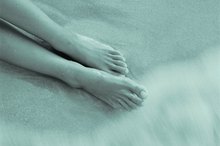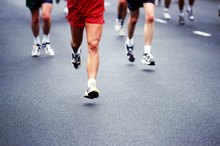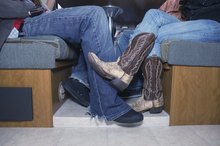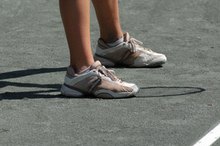What Are the Causes of Poor Knee Circulation?
Poor blood circulation, especially in the knees, is a common problem with older people, mostly because it takes a long time to develop. As with most blood circulation problems, the most common cause of poor knee circulation is the buildup of fatty deposits that result in the development of plaque in the arteries. This leads to reduced blood flow that can affect every area of the body.
If you are experiencing serious medical symptoms, seek emergency treatment immediately.
More O2, Please
Poor blood circulation can indicate another health problem. It could mean that the body is not getting enough oxygen in general. If the brain is not getting enough oxygen, brain function can be affected. If the heart is not getting an adequate flow of blood, it can result in chest pain and high blood pressure. People with poor blood circulation may have difficulty walking even short distances without having chest pain and shortness of breath. Lack of oxygen can affect even the liver and kidneys.
- Poor blood circulation can indicate another health problem.
- If the heart is not getting an adequate flow of blood, it can result in chest pain and high blood pressure.
Healthy Living
Circulation Problems in the Arm
Learn More
One of the major causes for poor knee circulation is diet. If people consume diets high in fat, they risk developing circulation problems. Exercise is also important. People who exercise regularly--at least a few times per week--run less risk of developing circulation problems because exercise helps prevent the buildup of plaque in the arteries. Smoking can lead to circulation problems as well. Having a healthy lifestyle goes far in preventing circulation problems in any area of the body, especially in the knees.
- One of the major causes for poor knee circulation is diet.
- If people consume diets high in fat, they risk developing circulation problems.
Peripheral Artery Disease (PAD)
Poor blood circulation in any part of the body can be a symptom of a much more serious health problem. In the knees, legs and feet, it could be a symptom of peripheral artery disease (PAD), a partial or complete blockage of the circulation to the legs and feet. The risk factors for PAD include:
- high blood pressure
- smoking
- abnormal blood cholesterol
- diabetes
- advanced age
- a sedentary lifestyle
Older men are especially susceptible to PAD.
Home Remedies and Exercise
How to Dissolve Blood Clots With Exercise
Learn More
Many patients report relief from poor knee circulation by using natural solutions and doing exercises that focus on the affected areas. Rosemary and gingko, which are available both in pill form and as herbal teas, are two herbs best known for treating circulation problems. Exercises that stretch the muscles around the knee are also a good idea. Always consult a physician before taking any supplements or beginning an exercise program.
- Many patients report relief from poor knee circulation by using natural solutions and doing exercises that focus on the affected areas.
- Rosemary and gingko, which are available both in pill form and as herbal teas, are two herbs best known for treating circulation problems.
Prevention
Poor blood circulation is preventable. If it occurs, there are effective treatments for it. The most common treatment is simple: getting buildup plaque under control by changing the diet and exercising more. Diabetics should keep their blood sugar under control. There are also some highly effective drugs, and vascular surgery can correct specific arterial problems.
- Poor blood circulation is preventable.
- There are also some highly effective drugs, and vascular surgery can correct specific arterial problems.
Related Articles
Writer Bio
Christine Meyer has been a freelance writer since 2009. She has done academic writing for several services across the Web and specializes in creating online content. She is a licensed professional counselor and has been a sign language interpreter, with fluency in American Sign Language. She holds a Master of Science in counseling from San Francisco State University.









